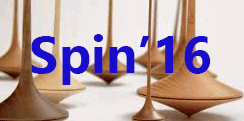Speaker
Description
Recent Lattice QCD calculations have supported the long standing quark model expectation of many more excited states of the nucleon than have been experimentally observed. Detailed partial-wave analyses (PWA) fit to many polarization observables are required to search for such ”missing states. Furthermore, the separation of isoscalar and isovector couplings to isospin 1/2 resonances requires information from both proton and neutron reactions. The present data base of neutron reactions is very sparse. To address this issue, the Jlab g14/E06-101 experiment was performed during 2011-2012 using the CLAS with circularly and linearly polarized photons incident on longitudinally polarized Deuterons in frozen-spin targets of solid Hydrogen-Deuteride (HD). Studies of experimental and theoretical methods that infer ”free neutron” spin observables from deuteron data are ongoing. Preliminary results for the single-pion channel, γ + n (p) → π− + p (p), will be discussed. Beam-target helicity asymmetries (E) have been extracted from data with circularly polarized photons. Data with linearly polarized photons have been used to extract the beam asymmetry Σ , along with the beam-target asymmetry G. The preliminary results for the E, Σ and G asymmetries will be compared to existing PWA predictions.
